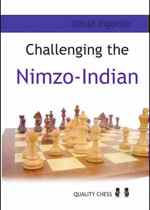Challenging The Nimzo-Indian
David Vigorito

Don’t be surprised if the kindly New England IM David Vigorito ends up with the nickname “Dave the tree killer or ends up on an “Earth First! watch list. His crime? The publication of a monster, large format 325 page book on the 4.Qc2 Nimzo-Indian and another equally large tome on the Slav-Slav soon to follow. It wasnt too long ago that a 325 page book on the Nimzo would have been considered something but now, thanks to the publisher Quality Chess, authors are being allowed to really zero in and focus.
Challenging The Nimzo-Indian deals exclusively with 1.d4 Nf6 2.c4 e6 3.Nc3 Bb4 4.Qc2. Its not the first book on the subject as GMs Max Dlugy and Ivan Sokolov both authored works on it in the 1990s but both are dated as a curious aside, did Max ever play 4.Qc2? I couldnt find any games in Mega and clearly remember his pet line being 1.d4 Nf6 2.c4 e6 3.Nf3 b6 4.g3 Ba6 5.Qa4 clearly not 4.Qc2 in the Nimzo. You can safely put the Dlugy and Sokolov books in a box as Challenging The Nimzo-Indian has everything you need to combat one of Blacks solidest and most respected weapons to 1.d4.
Vigorito writes in the informative introduction that having qualified for the US Championship he wanted to play 1.d4 with a punch and that playing 3.Nf3 after 1.d4 Nf6 2.c4 e6 wasnt going to cut it. Not only would Black have the choice of a Queens or Bogo-Indian but he could also steer back into Queens Gambit Declined where White had lost options (with Nf3 in there would be no immediate Exchange Variation and the option of a QGD Exchange variation with Nge2 is gone). He decided to combat the Nimzo and that 4.Qc2 would be the essential core of his principled 1.d4 repertoire.
Challenging The Nimzo-Indian is the result of Daves US Championship work. It covers all Black tries 4…0-0, 4…c5, 4…d5 and 4…Nc6/…d6 in great depth, primarily with variations but also with lots of explanation. Such an approach might sound like pretty tough reading but Vigoritos prose and the spacious Quality Chess layout complete with a 16(!) page index make the book a pleasure to use. Vigorito doesnt back done from critical lines (especially those occurring after 4.Qc2 d5 5.a3) and isnt an unobjective cheerleader for White. Many times in his chapter conclusions, Vigorito writes that Black is doing well theoretically and that White should try something different that he (D.V.) has given new original analysis on. Good theoretical novelties are always appreciated!
One other strength of this book is the authors feel for 4.Qc2. While he doesnt specifically advocate a line for Black, he does suggest what might work well for a certain type of player. For example for a solid Black player who doesnt relish long theoretical lines 4.Qc2 d5 and now 5.cxd5 Qxd5 6.Nf3 Qf5 or 5.a3 Bxc3+ 6.Qxc3 dxc4 should fit the bill. The latter he dubs the Short Variation. In fact Vigorito has given names to a lot of otherwise unnamed variations. Such an approach has the possibility to explode in ones face but I think Vigorito has chosen well selecting players who were the first to successfully play a line and use it repeatedly.
I give Challenging The Nimzo-Indian a strong recommendation.
